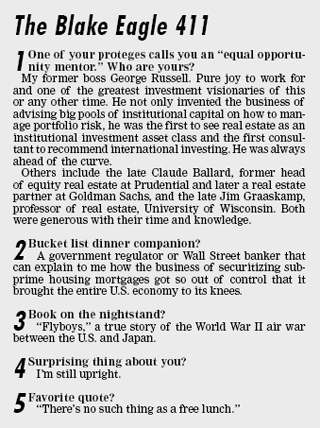|
Subscribe / Renew |
|
|
Contact Us |
|
| ► Subscribe to our Free Weekly Newsletter | |
| home | Welcome, sign in or click here to subscribe. | login |
Real Estate
| |
 |
December 2, 2011
Blake Eagle

Eagle
|
Blake Eagle founded the National Council of Real Estate Investment Fiduciaries (NCREIF), a Chicago-based nonprofit commercial real estate industry association.
The association collects, processes, validates and publishes investment performance return information on commercial real estate assets owned in the private market by pension funds, endowment funds and other institutional investors.
Prior to his involvement in the association, Eagle was the Thomas G. Eastman Chairman of the Center for Real Estate at MIT. From 1971 to 1993, Eagle headed up the real estate consulting group of Frank Russell Co. in Tacoma.
Q: Your vision manifested itself into a powerful repository of research and information built on transparency and integrity. Do you ever step back and grasp the impact this has made on decades of financial decisions, not to mention affecting millions of actual “people”?
A: I do look back and marvel at how transparent the markets have become over the past 30 years.
I joined Frank Russell Co. (today Russell Investments) in the early 1970s to head up its newly formed real estate consulting practice with the mandate to look into the case for why pension funds would want to add this asset class to their portfolios.

Russell was not only on the leading edge of real estate investment research, it pioneered an effort to convince the real estate industry that it would be in its best interest to make the market much more transparent. This would be particularly true if the real estate industry wanted to tap a huge source of capital that heretofore had avoided real estate — U.S. pension funds, and, at that time, among the largest pools of investable capital in the world.
Russell saw the commercial property market as a huge asset class that institutional investors had avoided — largely due to lack of quality information on real estate risk and return.
It took time, but eventually we were able to convince those offering real estate investment management services to pension funds to work with Russell in constructing a real estate performance index. The objective was to allow institutional investors to observe how real estate performed over time compared to other asset classes and how a given manager’s performance compared to an industry standard measure of performance.
The successful development of the NPI (NCREIF Property Index) was the catalyst for others to go into the real estate information business. As more institutional capital invested in real estate, there was a demand for better information.
Today both the space markets and the real estate capital markets are tracked and reported on by a plethora of information providers. The information they offer has been tested and back tested by the research community and academia.
Q: What commercial real estate investment trends are you seeing?
A: In the institutional investor community, the general trend is back to basics. The investment objectives sought are relatively high current yield, 200 to 300 basis points north of 10-year treasuries, capital preservation and some prospects for future rental growth. These are all the reasons why they began diversifying into real estate some 30 years ago.
At the top of their shopping list: high-quality, substantially leased operating properties. They will buy for all cash. Leverage is OK at modest levels; 25 percent to 40 percent favored sectors include apartments, urban office, industrial warehouses and neighborhood shopping centers. They will also consider medical office, student housing and self-storage.
The higher return/higher risk strategies known as “opportunistic” and “value-add” continue to attract institutional capital, but not nearly as much today as in the recent past. A lot of this money is sitting on the sidelines. Despite the fact that billions of dollars of over-leveraged commercial real estate experienced huge declines in value, a product of the Great Recession, there has yet to take place the distressed asset sales at deep discounts to replacement cost that many in the market expected.
The biggest concern institutional investors have, which is the same for most of the rest of us, (is) when does the economy start expanding at a rate sufficient to increase employment, that in turn will generate increases in the demand for commercial real estate space?
Q: With our relatively strong employment, Seattle has been setting building sales records this year as office vacancies have been falling and rents have risen. What is the national perception of the Seattle market?
A: Seattle is on just about every institutional investor’s shopping list. I would place it in the top 10 of the most sought after markets.
At the end of the third quarter 2011, the NCREIF property index included 241 properties located in the Seattle metro market, valued at $8.5 billion. The number of properties is equal to 3.7 percent of the total of 6,489 properties that made up the index at the end of the third quarter. They represent 3.1 percent of the index’s third-quarter market value of $272.7 billion.
Seattle meets most, if not all the locational criteria institutional investors look for, and it is moving up as a target market, meaning they want to increase their exposure to Seattle.
Seattle is classified as a “gateway city” meaning the local economy is linked to the global economy. As such, Seattle is an international port city, handling both import and export trade. As a high-tech center, Seattle contributes to having a highly educated population. The University of Washington is recognized around the globe as a top research university. The Seattle economy is growing, its population is increasing — all demand drivers for the use of commercial real estate.
Seattle is also looked upon as a city with “barriers to entry” — meaning its physical layout makes it difficult and costly to engage in excessive speculative development.
There is absolutely nothing on the horizon to suggest Seattle will be viewed any differently for quite some time.
Q: In a recent survey of institutional investors and investment consultants by Pension & Investments, 42 percent of respondents said that multifamily housing was the most attractive real estate sector over the next 24 to 36 months. Office/commercial was a distant second at 19 percent. Agree?
A: I definitely agree that investors and their agents see multifamily as the sector offering the best prospects for above-average returns in the near term. Apartments have been the top performer in the NPI for the past three years.
There are several reasons why apartments are on everyone’s shopping list.
The national apartment vacancy rates are in the low single digits. There is in the offing, a demographic surge coming in the prime renter age group as the echo boomers move into the household-forming age. Elevated foreclosure rates in single-family housing and many would-be-home owners questioning the “American dream” to own a home after the housing bubble burst, is resulting in a migration from home ownership to rental housing.
For the immediate future, all these dynamics favor the apartment market. How long it will be before developers can jump in and crank up the supply side is an unknown. Availability of construction and mortgage financing will dictate whether the apartment market eventually gets overheated or not.
All high-quality operating, leased, and income-producing commercial real estate is in demand by the institutional investor. There is no shortage of equity capital for this product. At this point in the cycle, I do not see a commercial real estate bubble in the making. So far at least, from my vantage point, trading prices reflect the realities of the market, the inherent risks in real estate, and the trading prices of the other asset classes.
Q: You’re retired, yet you wouldn’t know it looking at your schedule and level of energy. What keeps you going?
A: I have enjoyed every minute of the trip I have been on over the past nearly 50 years, and since my health is good, I see no reason not to stay active in the business. I have been most fortunate in the opportunities afforded me.
— Interview conducted by Barbara Travers
Other Stories:
- Insights breakfast is all about fundamentals
- Tourism, conventions, real estate — a valuable connection
- CBA Roundtable
- Strong vital signs for health-care real estate
- Investors turn aggressive on industrial properties
- For offices, it feels like 2007 all over again
- Owners, here’s how to hire the right project team
- Rob McKenna
- Brokers catch on to the green movement
- Banks find a comfort level for lending
- Jerry Yudelson
- Is multifamily’s future in ‘transit communities’?
- Retail begins to reset, refill


